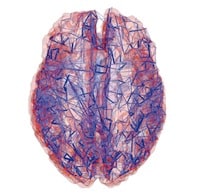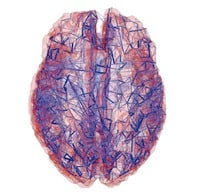
A proposal alluded to by President Obama in his State of the Union address to construct a dynamic “functional connectome” Brain Activity Map (BAM) would leverage current progress in neuroscience, synthetic biology, and nanotechnology to develop a map of each firing of every neuron in the human brain—a hundred billion neurons sampled on millisecond time scales. Although not the intended goal of this effort, a project on this scale, if it is funded, should also indirectly advance efforts to develop artificial intelligence and atomically precise manufacturing. In his blog, Robert L. Blum provides an excellent overview and brief introduction. From “BAM: Brain Activity Map: Every Spike from Every Neuron“:
A recent research proposal called BAM for Brain Activity Map Project generated much excitement. (The BAM proposal, published in Neuron in June 2012 is online, and an earlier draft with far greater detail is also online.)
(Addendum: 18 Feb 2013: I started drafting this story in Nov, 2012. Today it was headline news when it was made public that THIS is the very proposal that President Obama alluded to in his recent State of the Union address. See John Markoff’s NY Times piece. NIH is drafting a 3 billion dollar, 10 year proposal to fund this project. Also see this 25 Feb 2013 NY Times follow-up by Markoff.) …
The essence of the BAM proposal is to create the technology over the coming decade to be able to record every spike from every neuron in the brain of a behaving organism. While this notion seems insanely ambitious, coming from a group of top investigators, the paper deserves scrutiny. At minimum it shows what might be achieved in the future by the combination of nanotechnology and neuroscience. …
The Neuron article cited by Blum argues that in addition to breakthroughs in basic science with large medical and economic benefits, the BAM project will advance technology in terms of important general capabilities.
Many technological breakthroughs are bound to arise from the BAM Project, as it is positioned at the convergence of biotechnology and nanotechnology. These new technologies could include optical techniques to image in 3D; sensitive, miniature, and intelligent nanosystems for fundamental investigations in the life sciences, medicine, engineering, and environmental applications; capabilities for storage and manipulation of massive data sets; and development of biologically inspired, computational devices.
I think the emphasis on nanosystems of nanodevices integrated to provide complex functions is very important, even if many or most of those devices will, in the beginning, not be atomically precise. The more detailed description of the BAM proposal cited by Blum above hints at how nanoparticle-based sensors could be developed to noninvasively provide micrometer-scale spatial resolution and millisecond-scale temporal resolution to groups of millions of neurons deep inside the brain of a living, active animal (or human). The mention combining semiconductor quantum dots and nanodiamonds with organic nanostructures to functionalize them, so that they may be directed to and embedded in neural membranes to monitor synapses. In addition, nanotubes or nanowires could be developed to deliver photons to specific locations, or collect or release specific chemicals. Further, they suggest developing graphene into membrane patches for detailed monitoring of neurons. Taken together, the requirements for this ambitious project entail the need to develop a variety of nanoparticles for specific applications, and then integrating multifunctional nanoprobes, nanoparticles, and nanodevices into large functional systems, and producing such nanosystems en masse.
In his NY Times report John Markoff notes the possible effect of this project on the development of artificial intelligence: “Moreover, the project holds the potential of paving the way for advances in artificial intelligence.” Indeed, the information to be provided by BAM about how circuits of thousands or millions of neurons work should advance Ray Kurzweil’s program of reverse engineering the human brain to develop artificial general intelligence, as described in his new book How to Create a Mind: The Secret of Human Thought Revealed.
The next best thing to large program to develop molecular manufacturing is a large program aimed at other worthy and useful goals that also makes heavy use of nanotechnology and may promote some of the same or similar enabling technologies that will lead toward productive nanosystems.
—James Lewis, PhD
